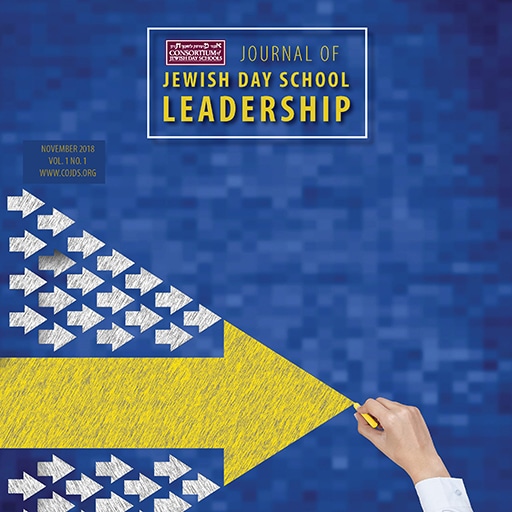
Seeking Submissions
January 3, 2022
CoJDS’ Curriculum Development–A Closer Look
January 17, 2022by Rabbi Steven Penn
Our school had planned a Chumash curriculum review for the 20-21 school year, in conjunction with the Middle States Association (MSA-CESS). Unsurprisingly, we needed to shelve the planned revamp as we turned our primary focus to dealing with the daily challenges of the COVID-19 upheaval. Nevertheless, to our surprise, COVID itself created an incentive and an opportunity for some genuine curricular strides in our lower school.
To achieve the smaller class size that our medical committee advised, we needed to increase the number of classes. This was at the very moment when we were losing some experienced teachers due to COVID concerns and for other reasons. The infusion of a higher number than usual of new faculty in a single school year motivated us to prioritize writing down our school’s approach to chumash as a guide for the new teachers. And having a veteran teacher who had worked on curriculum intermittently over the years and was now unable to teach in school because of COVID, meant we had a staff member available to undertake the project.
Our goal for now was not to revamp but to assure the maintenance of our normal high standard. We needed to introduce our new teachers to our expectations and to our school’s approach to chumash education. To do that, we needed to put it into words. What had mostly been our “Torah Shebe’al Peh,” – our new teachers were usually mentored by veterans and often spent part of their day observing an experienced teacher in the same grade – was ill-suited to the world of COVID pods. We already had a written curriculum for 3rd grade prepared by the same person who would now write up 4th and 5th grade chumash curricula. Starting in the summer, she worked in triage mode going back and forth between the two grades, providing the material for each new perek and parsha days before they reached it. A few of the big ideas that underlie this curriculum follow.
Chumash Goals
For us, a listing of specifics, although included, was secondary. Primary was communicating our priorities and standards.
With every unit of Torah text, we ask the teacher to focus on three things.
- Context: Teachers need to place the text on the Tanach timeline and the map as well as provide relevant historical background. Teachers encourage students to think about context and to wonder: How much time has elapsed since the previous episode? Where is this happening? Where are the people we met in the previous episode now?
- Mastery of the text: When it come to the Torah text itself, we want to enable our students to advance in language skills and thinking skills.
- Language
- Acquire an increasingly broad vocabulary and advance in understanding of biblical syntax and grammar.
- Translate precisely into ivrit kalah and English. (Although discussions should be conducted using phrases from the actual language of the Torah text without constant translation, translating with precision is an important skill. In successive elementary grades increasing independence with translation is our aim.)
- Comprehension
- Become proficient at scanning the Torah text for information.
- Be able to divide a perek into sections and give the sections titles.
- Be able to write a summary using the “Collins Method” or some other template.
- Thinking
- Constantly compare and contrast (Ma domeh? Ma shoneh?)
- Be alert to similarities, differences, patterns, and apparent redundancies.
- Generate questions (and attempt answers).
- Be able to participate in a discussion using supporting texts.
- Language
- Personal Response: Making time for a student’s personal response is essential. Projects and activities that invite students to react to the Torah text as individuals and to share their reactions strengthen the bond with Torah. Most important is the modest undertaking of asking “What do you think?”, “Can you relate this to your life?”, “If this passage were made into a movie, what kind of background music should there be?”, etc. Mastery is empty without an opportunity for the personal response that is the foundation of a lifetime enthusiasm for Torah study.
Rashi – Timing
There are several priorities we mapped out regarding teaching Rashi. The reader will have noticed that there is no mention of Rashi so far. That is because in our school we teach an entire perek, review it, and do an assessment, before introducing the Rashis for that perek. It has been our experience that learning the Torah text well before beginning the Rashis has several advantages:
- Students don’t confuse Rashi with Torah.
- Students have a chance to ask their own questions about the text as they first learn it and sometimes propose solutions. It’s great when the teacher can say, “Rashi asks that same question.”
- Perhaps most important of all, delaying Rashi has an equalizing effect. It allows average and weaker students to be full participants in the Rashi experience. Mastering the language of the Torah requires much more time and effort from some students than it does from others. By waiting until the entire perek has been learned, studied, reviewed, and assessed, the entire class is able to bring at least 80% mastery of the language of the pesukim to their Rashi study. This allows more of the students to comprehend the textual issues to which Rashi is responding.
Rashi – Analysis before Drill
In our curriculum we list the Rashis required in each perek as well as a list of “stretch” Rashis for more advanced students. The teacher can select extra Rashis (or comments from other parshanim) as well. We also include suggestions on how to present the required Rashis.
The logic of Rashi is a challenge even for well-prepared 4th graders. This makes it tempting to hand out a “Rashi booklet” which makes everything clear right off the bat. However, doing that turns Rashi study into a “spit back” task instead of an opportunity to go through the process of grappling with Rashi. By delaying the study of Rashi until after mastery of the Torah text, we maximized the number of students who followed Rashi’s logic. Only after the class has contended with the analysis, do we distribute the “Rashi booklet” for written work and studying so that nearly all students will ultimately be successful on an assessment. This system for teaching Rashi is new for most teachers and requires a bit of guidance. Generally, those who try it like it.
Conclusion
By the end of this school year, we will bli neder have completed this project of recording what we have been doing in our chumash classes and clarifying why it has been done this way.
It is anticipated that this year’s curriculum writing for three grades, undertaken to weather a crisis, will serve us well as a starting point for the 2021-2022 school year when we undertake the Middle State goal for our chumash curriculum. Our discussions will be able to begin with an agreed-upon description of our policies, pacing, and priorities until this point. It is our hope that a document designed to shore up our chumash instruction this year will prove to be an asset in our quest to go michayil el chayil.
Rabbi Steven Penn is the Associate Head of School and Lower School Principal at Yavneh Academy, and is responsible for supervising the Judaic studies department in grades 1-5. He oversees curriculum, develops and implements programs focusing on Middot, Kindness and Chesed. He served as assistant headmaster at the Ramaz Lower School in Manhattan for 7 years. Rabbi Penn holds a master’s degree in Jewish education from the David J. Azrieli Graduate school of Jewish Education and a bachelor’s degree in psychology from Yeshiva University. Email Rabbi Penn at [email protected].

